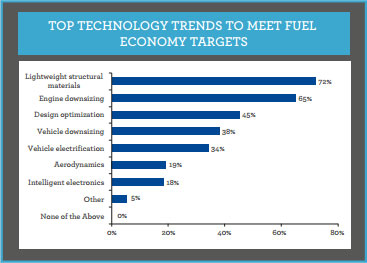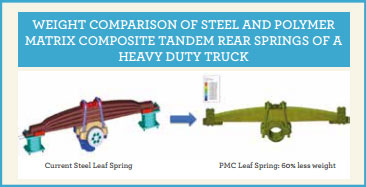Lightweighting For Heavy Trucks
23 May 2017
İsmail Erhan Eyol
The title of this article inevitably creates a sense of oxymoron, like an excerpt from Shakespeare's Romeo and Juliet; but the concept of “lightweighting”, now seen as a megatrend, is at the center of Ford Otosan’s product development of heavy trucks. As such, the collaborative work with Kordsa in the field of composites is of great importance. However, rather than skipping straight to the details of the work, let us first clarify the concept of lightweighting and the motivation behind it.
An effective lightweighting strategy is about much more than simply replacing a few steel parts with aluminum or composites; it is about using the correct material for the correct part in the correct place. Ford’s portfolio extends from the Ka+ city car to heavy-duty trucks. With such a broad range, it would be impossible for an OEM of this size to introduce a group-wide material-specific lightweighting policy. Instead, Ford concentrates on design optimization and the use of application-specific materials.
 Lightweighting has become a holistic concept, improving not only fuel economy and emissions but also vehicle performance and handling. The next generation of transportation vehicles will be required to be fuel efficient, low emission, low maintenance vehicles that are designed for safety. They will possess an extraordinary range of sensors and electronics. Weight reductions will therefore be vital to satisfying the increased demands on performance, while also complying with far stricter regulations on fuel economy and emissions. Incidentally, a survey made among members of SAE reveals that the top choice for best fuel economy should be lightweighting (Fig. 1).
Lightweighting has become a holistic concept, improving not only fuel economy and emissions but also vehicle performance and handling. The next generation of transportation vehicles will be required to be fuel efficient, low emission, low maintenance vehicles that are designed for safety. They will possess an extraordinary range of sensors and electronics. Weight reductions will therefore be vital to satisfying the increased demands on performance, while also complying with far stricter regulations on fuel economy and emissions. Incidentally, a survey made among members of SAE reveals that the top choice for best fuel economy should be lightweighting (Fig. 1).
In our line of work, heavy-duty vehicles are those with more than 16,000 kilograms of gross vehicle mass. These include highway tractors, construction trucks (e.g. cement mixers, concrete pumps), road trucks, etc. Reducing CO2 emissions in line with ever-changing regulations and cutting fuel consumption requires a decrease in vehicle weight. In ground transportation, the motivation to reduce weight differs according to the industry. For the on-highway trucking business, there is a weight restriction for each class, so the lightweighting effort is often focused on maximizing payload. Great e orts are being made to reduce the weight of heavy trucks that reach the allowable weight limit during service, and this sector that has been an early adopter of new technologies to achieve this aim. Diesel-powered trucks and tractors have become hundreds of kilos heavier over the last decade due to pollution-control equipment, heavier radiators etc. Reducing the curb weight of these trucks is the best way to make up for this.
Composites for Lightweighting
The aforementioned SAE survey also looked at the lightweight materials of the future, and composites came out as the top contenders (Fig. 2). Compared to conventional automotive materials such as steel, magnesium and aluminum, advanced composite materials can o er the following benefits:
- Superior stiffness-to-weight and strength-to-weight ratios
- Higher specific damage tolerance and energy absorption properties, providing improved crash-worthiness
- Higher fatigue and corrosion resistance for better long-term durability (reducing warranty costs)
- High-energy absorption for reduced noise and vibration (NVH)
- Highly tailorable mechanical properties for specific applications
- More flexibility for the design of complex shapes to provide improved styling
- Ability to provide multi-functional, integrated systems and components, thereby reducing part count and assembly time
- Good surface quality for use in exterior body panels
- Ease of embedding sensors for continuous monitoring of reliability
The Work at Ford Otosan
 Ford’s efforts to reduce vehicle weight have been well publicized: the GT, launched in 2005, was the first all-aluminum Ford. In 2014, Ford unveiled the Multi-Material Lightweight Vehicle concept and the aluminum-bodied F-150, followed by the carbon fiber-bodied GT supercar in 2015.
Ford’s efforts to reduce vehicle weight have been well publicized: the GT, launched in 2005, was the first all-aluminum Ford. In 2014, Ford unveiled the Multi-Material Lightweight Vehicle concept and the aluminum-bodied F-150, followed by the carbon fiber-bodied GT supercar in 2015.
The reflection of this vision on heavy trucks is inevitable, and we in the department of Chassis Engineering have been looking at every vehicle part for lightweighting, including critical structural components bearing high loads, such as air reservoirs, wheels, cross-members, pedal boxes, battery trays etc. Chassis Engineering deals with suspension, brakes, steering, frames, wheels and tires; all critical in every attribute of the vehicle. As an example, below is a depiction of a project carried out in collaboration with Kordsa, and with the support of the Scientific and Technological Research Council of Turkey (Fig. 3). Even a leaf spring subjected to many tons of weight at the rear of an HDV can be redesigned as a composite part.
Computer-Aided Analysis (CAA can help validate the design of composite components. The diagram above shows the initial stage carried out during this project, where significant know-how was acquired as to how a composite structure carrying such high loads can be attached to steel structures (in this case, to the trunnion system via u-bolts). The next step will be the assessment of the correlation of results versus physical tests.
When designing with composites, it is imperative to utilize methods of contemporary engineering to maximize production, quality, and mechanical properties. Since the manufacturing process can significantly affect all of these properties, it is important to develop the process during design. The primary manufacturing method reviewed and chosen during the design process for this part is capable of producing high quality parts in a scalable process.
Autonomous Trucks and Lightweighting
 The global autonomous heavy-duty truck market is gaining momentum, with most major heavy truck manufacturers, including Ford Otosan, trying to make their mark in this competitive field. There are discussions as to whether this could result in reduced demand for passive safety features, as such vehicles aim to nullify accidents, hence requiring fewer parts or parts with lessened strength. However, predictions suggest that 15% of vehicles on the road in 2030 will have some form of autonomous drive technology. This means that safety regulations may change, but are unlikely to relax. A significant impact on the choice of materials is therefore not expected from this perspective.
The global autonomous heavy-duty truck market is gaining momentum, with most major heavy truck manufacturers, including Ford Otosan, trying to make their mark in this competitive field. There are discussions as to whether this could result in reduced demand for passive safety features, as such vehicles aim to nullify accidents, hence requiring fewer parts or parts with lessened strength. However, predictions suggest that 15% of vehicles on the road in 2030 will have some form of autonomous drive technology. This means that safety regulations may change, but are unlikely to relax. A significant impact on the choice of materials is therefore not expected from this perspective.
CONCLUSION AND FUTURE WORK
Despite the challenges, lightweighting and material selection will continue to be a megatrend for many equipment manufacturers striving to meet increasing attribute expectations while also maintaining productivity and payload capabilities. The use of structural composites is a critical component for technological progress in the automotive industry. In order to speed up the adoption of these materials, we need a fuller understanding of their physical properties and processing behavior. These factors have an impact on the durability, reliability, and a ordability of structural composites, and this impact needs to be assessed correctly to obtain the best possible balance between all these elements. The collaboration between Ford Otosan and Kordsa, initiated by the composite leaf spring work, will maintain its importance, with plans for the findings of the project to be transferred to use on other chassis parts, from wheels to cross-members.